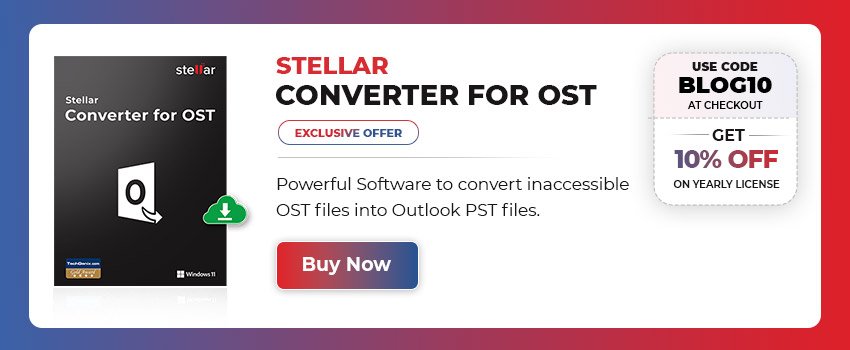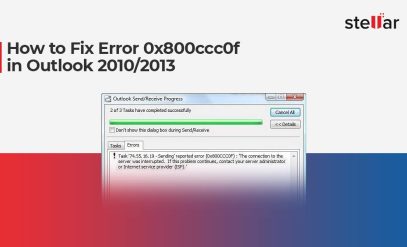| Summary: Have you ever been confused about the difference between OST and PST files? Well, you’re not alone! With so many variations in email file formats, it’s easy to get lost in their technical jargon. One thing that makes Outlook stand out is the fact that it uses two different types of files to store data – PST and OST. These two types of files are used in Microsoft Outlook for different purposes, but understanding which one to use can be tricky. |
|---|
In this blog post, we’ll help you understand the differences between OST and PST files so that you can make informed decisions when working with your email and data in Outlook. We will also take a look at why you should consider Stellar Converter for OST as an OST to PST converter software.
But before we dive into it let us talk about the basics, shall we?
Also Read: Introduction to OST File, its Problems and Solutions
What is OST?
OST files are created when you use Microsoft Outlook in an offline mode. In this mode, Outlook downloads a copy of your mailbox from the Exchange server and saves it on your computer. This stored copy is known as an OST (offline storage table) file. OST files are useful if you need to access your mailbox when you’re not connected to the Exchange server (for example, when you’re traveling).
Also Read: How to Recover Deleted E-Mails with the Help of Stellar Converter for OST?
What is PST?
PST stands for Personal Storage Table, and it is the file type that is used to store data on your local hard drive. This means that if you want to access your emails offline, or if you want to back up your data, you can do so by exporting your PST file.
Now that we know what are OST and PST files, let us talk about the advantages and disadvantages of OST and PST files to better understand them.
Advantages of OST
You can work offline or have access to your mail even when the Exchange server is unavailable.
- All changes made to items in your mailbox are synchronized with the Exchange server the next time you connect.
- If your computer crashes, you will not lose any data because it is all stored on the Exchange server.
- OST files use less disk space than PST files because they only store a copy of items in your mailbox and do not duplicate as PST files do.
Disadvantages of OST
- If you delete an item from your mailbox on the Exchange server, it will also be deleted from your OST file unless you have set up Outlook to keep a copy of deleted items on your computer.
- When you synchronize an OST file with an Exchange account that has been moved or reconfigured, you will usually receive an error message and be unable to synchronize. In this case, you would need to create a new OST file.
Advantages of PST
- PST files are compatible with a variety of email clients, including Microsoft Outlook and Apple Mail. This makes them a good choice if you need to archive emails from multiple accounts.
- PST files are relatively easy to back up and restore. You can even use free tools like 7-Zip to compress them, which can save space on your hard drive.
- PST files offer some protection against data loss. If your computer crashes or you accidentally delete an email, you can usually recover the data from the PST file.
Disadvantages of PST
- PST files can become corrupt if they are not maintained properly. If you don’t regularly back up your PST file, you risk losing all of the emails stored in it.
- PST files can take up a lot of space on your hard drive. As your email archive grows, the size of the PST file increases as well.
- PST files are not accessible by other programs or services outside of Outlook or Apple Mail. This means that you may have to export them to a different format in order to use them in other contexts.
- PST files are not supported by all email clients, so if you switch email providers, you may not be able to access your old emails.
Also Read: Introduction to OST File, its Problems and Solutions
Difference between OST and PST
Server Compatibility
When it comes to server compatibility, OST files are designed to work with Microsoft Exchange Server, while PST files are not. This means that if you try to open an OST file with a program other than Microsoft Exchange Server, you will most likely get an error message. PST files, on the other hand, can be opened with a variety of programs, including Microsoft Outlook, Apple Mail, and Mozilla Thunderbird.
File Size
OST files are typically much larger than PST files. This is because OST files contain a copy of all of the data from the Exchange Server, including all of the email messages, contacts, tasks, calendar items, etc.
That means that an OST file can be several gigabytes in size, while a PST file is usually only a few megabytes in size.
Usage
OST files are designed to be used offline, while PST files are designed to be used online. That means that if you want to use your email offline, you’ll need to use an OST file. But if you only need to access your email when you’re online, then you can use a PST file.
Corruption Issues
OST files can become corrupt if they’re not properly synchronized with the Exchange server, or if they’re damaged due to a hardware or software failure. When an OST file becomes corrupt, it can prevent Outlook from accessing your mailbox data. This is where a tool like an Free OST to PST Converter comes in handy.
The maximum size for a PST file differs according to versions going from 2GB to 50GB, and once it reaches this limit, it can become corrupted and unusable.
If your PST file becomes corrupted, you will not be able to access any of the data that is stored in it. Another way it can get corrupted is the file is not properly closed when Outlook is shut down. This can happen if Outlook crashes or if the computer is shut down without first closing Outlook
Accessibility
When it comes to the difference between OST and PST, accessibility is one of the key considerations. PST files are only accessible when connected to the Exchange server, while OST files can be accessed without a connection. This means that if you need to access your email offline, you’ll need to use an OST file.
Also Read: Unlock the Secret: Free Methods to Convert OST to PST in Outlook
Conclusion
In conclusion, OST and PST have some major differences that make them better suited for different scenarios.
OST files are ideal when you need to keep a copy of your email data on the hard drive while PST files are best used for backing up emails or transferring information between computers and mail accounts.
No matter which format suits your needs, both offer useful features that can help you manage large amounts of email data more efficiently.
If you are tired of struggling with inaccessible OST files then it’s time you invest in OST to PST converter software. OST to PST converter software is an invaluable tool for those who need to migrate their mailbox data from one platform to another.
With the help of this software, you can easily convert your Outlook OST files into PST format with ease and accuracy.
In today’s digital age, email communication is crucial for businesses and individuals alike. Fortunately, Stellar Converter for OST is a proficient OST to PST converter which makes it easy to convert your OST files into an accessible PST format with just a few clicks.
It offers advanced features like preview options and selective file conversion which helps users save time while converting their emails.
So, if you are looking for a reliable solution to migrate your email data then look no further than Stellar Converter for OST as your next OST to PST converter software!









